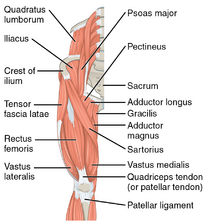Manual Muscle Testing: Hip Flexion: Difference between revisions
(image, words) |
No edit summary |
||
| Line 4: | Line 4: | ||
'''Top Contributors''' - {{Special:Contributors/{{FULLPAGENAME}}}} | '''Top Contributors''' - {{Special:Contributors/{{FULLPAGENAME}}}} | ||
</div> | </div> | ||
== Introduction == | |||
An assessment of [[muscle]] strength is typically performed as part of a patient's objective assessment and is an important component of the physical exam that can reveal information about neurologic deficits. It is used to evaluate weakness and can be effective in differentiating true weakness from imbalance or poor endurance. See [[Muscle Strength Testing]] | |||
== Muscles Involved == | == Muscles Involved == | ||
[[File:Hip flexors.png|right|frameless|224x224px]] | [[File:Hip flexors.png|right|frameless|224x224px]] | ||
Revision as of 05:56, 15 January 2022
Original Editor - Claire Knott
Top Contributors - Whitney Wagganer, Kaitlyn Carroll, Tony Varela, Claire Knott, Lucinda hampton, Kim Jackson and Wanda van Niekerk
Introduction[edit | edit source]
An assessment of muscle strength is typically performed as part of a patient's objective assessment and is an important component of the physical exam that can reveal information about neurologic deficits. It is used to evaluate weakness and can be effective in differentiating true weakness from imbalance or poor endurance. See Muscle Strength Testing
Muscles Involved[edit | edit source]
The Psoas Majot and Iliacus muscles are the main agonists of the hip flexor group of muscles.
Image 1: Anterior hip/thigh muscles.
Patient Positioning[edit | edit source]
- Grades 3 to 5 - Patient is in short sitting with thighs supported
- Grades 0-2 - Patient is in side lying ('gravity minimal' position)
Therapist Position[edit | edit source]
- Therapist to stand next to test side
- Palpation over hip flexors
To Test[edit | edit source]
- Patient actively flexes the hip
- For grades 4 to 5 apply resistance over the distal femur in a direction opposite to flexion[1]
- To satisfy grade 5 'normal muscle' performance criteria, the patient must have the ability to move through complete range of motion (active resistance testing) OR maintain an end point range (break testing) against maximum resistance.
References[edit | edit source]
- ↑ Hislop H, Avers D, Brown M. Daniels and Worthingham's muscle Testing-E-Book: Techniques of manual examination and performance testing. Elsevier Health Sciences; 2013 Sep 27.







